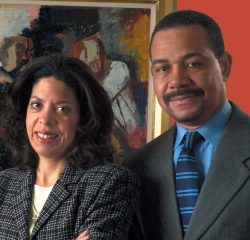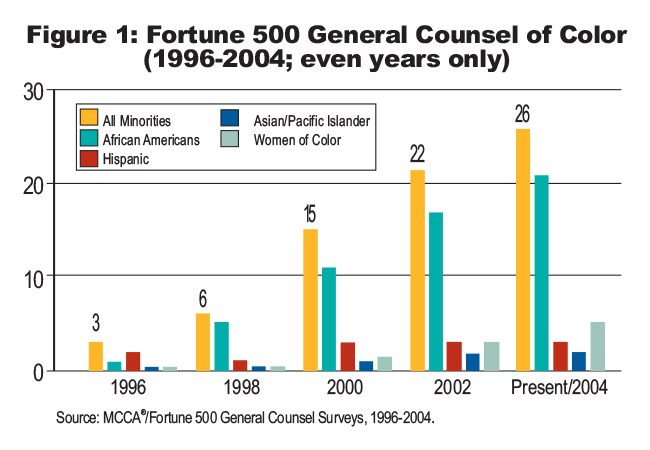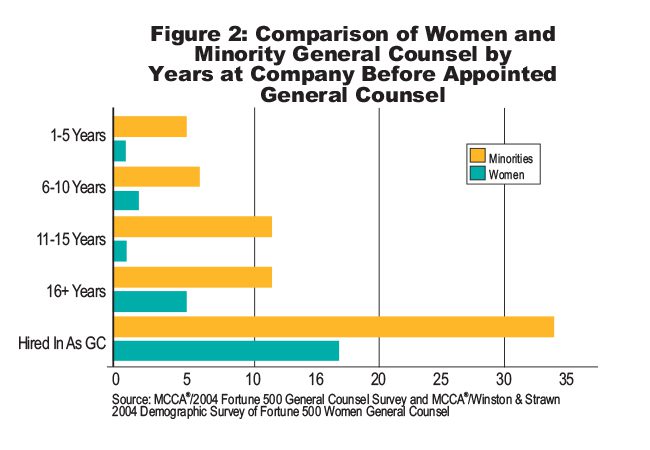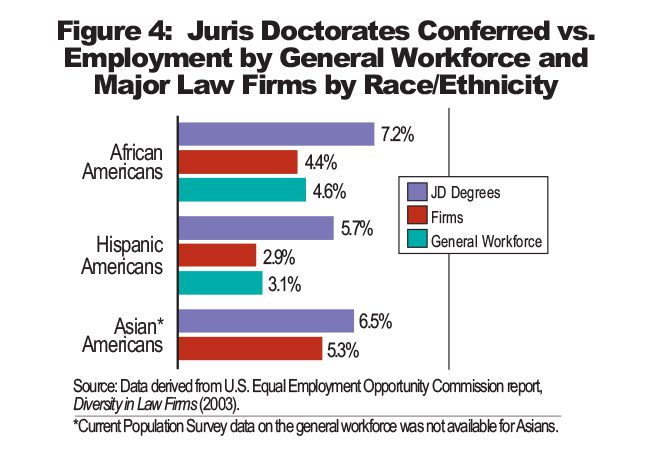MCCA® 2004 Report on General Counsel of Color Leading Fortune 500 Companies

(L to R): Andrea Zopp, general counsel, Sears, Roebuck and Co., and Roderick A. Palmore, general counsel, Sara Lee Corporation
Since 1997, MCCA® has surveyed diversity in corporate law departments across the nation, with a special emphasis on the advancement of attorneys of color to the leadership ranks of the nation’s largest companies. The latest trends are both promising and challenging. While women and attorneys of color have reached the general counsel’s office at unprecedented levels, they still represent a small percentage of the top law department jobs.
Today, 26, or 5.2 percent, of Fortune 500 general counsel are minorities, which according to MCCA records, is an increase of 23 since the first MCCA Fortune 500 General Counsel Survey conducted in 19961 (see Figure 1). Among the 2004 group, 21 are African American, three are Hispanic, and two are Asian/Pacific Islanders.2 Of the 26, five are women.
The rapid growth of this elite group has been a recent phenomenon, with most appointments taking place within the last six years. In the November 1999 Diversity & the Bar® article “General Counsel Share Keys to Success,” MCCA reported that there were only 11 general counsel of color (2.2 percent) in the Fortune 500.3 The findings led to the then-prediction by MCCA that the number of minority general counsel would double within the next 10 years.4 Just three years later, though, the number already had doubled, from 11 in 1999 to 22 in 2002.5 By October 2003, informal MCCA records indicate that this number had risen again to 31.




What appears to be a decrease of five general counsel from 31 in late-2003 to 26 today is actually the result of a down-turned economy that caused several companies to shift from the Fortune 500 to the Fortune 1000. All 31 general counsel represented in MCCA records still serve in general counsel positions at their respective companies. In April 2004, Deval Patrick resigned from Coca-Cola but will remain in the position of general counsel until the end of the year during transition.
This shifting within the Fortune 500 led MCCA to examine Fortune 1000 companies for the first time in order to publish the 2004 MCCA Fortune 1000 General Counsel Survey. MCCA found that minorities hold 43 chief legal officer positions in the Fortune 1000. Thirty-one are African American, seven are Hispanic, and five are Asian. Additionally, women of color account for 11 of these general counsel.
While general counsel of color are not limited to these large companies, the gains they have made there are representative of their numbers at other globally-ranked and major, privately held corporations. These leaders include Larry Tu of NBC (a subsidiary of General Electric); Cornell Boggs of Tyco Plastics & Adhesives (a Tyco International subsidiary); Karen Randall of Universal Studios and Johnny Taylor, Jr. of the Compass Group (both Fortune Global 1000 companies); David Drummond of Google, Vivien Tseng of Welch’s, and Richard White of The Auto Club Group – all major corporations, albeit not listed among the Fortune 1000.
Recently, MCCA sat down with 11 people of color who are general counsel at Fortune 1000 companies (see sidebar) to discuss the latest trends in the profession, and the rise of minorities to top corporate law jobs.
James R. Jenkins, senior vice president and general counsel of Deere & Company, attributes the relatively swift increase of general counsel of color to a confluence of factors over the past two decades. “First, there have always been outstanding minority lawyers; we just never had the opportunity to shine,” he says. “Second, many companies needed to significantly improve diversity within their ranks. And so, they chose to tap the pool of highly qualified minority lawyers as a source of talent for their boards and management teams, to strengthen shareholder relations, to preserve government business, and as a matter of good corporate governance and citizenship,” adds Jenkins.
Additionally, companies began to recognize that diversity lends a competitive edge. As expressed by Gordon Yamate, vice president and general counsel of Knight Ridder, “To be effective, our company needs to mirror the communities that it serves — from the front-line to upper management levels. It’s just good business practice.” This realization brought each of these factors to the forefront.
“The upside for minority attorneys in all of this,” says Chris Johnson, vice president and general counsel of General Motors North America, “is that because more and more corporate legal departments are transforming to match the changing demographics of their consumers and the country, there are an increasing number of opportunities for minority attorneys right now.”
Efforts by many general counsel of color have played an active role in the creation of such opportunities and the overall advancement of diversity in the profession. For example, Vernon Baker, senior vice president and general counsel of ArvinMeritor Inc., says that when a few of the company’s outside law departments declined to embrace the corporation’s diversity principles, he stopped doing business with them.
Baker also says he goes through law firms’ minority partners whenever possible to help them bring in business. “The emphasis is not on personal benefit, but to drive home the point that minority attorneys can and do bring in substantial business, and thereby encourage greater numbers of minority summer associates and new hires within firms,” says Baker.
Other general counsel, says Johnson, have instituted similar diversity initiatives that will have a profound impact on the legal profession over time — “and these efforts are not unique to minority general counsel.” The hoped-for result, which the 2004 survey reflects, is that with a greater number of successful minority leaders, those in authority will realize that minority attorneys are equally competent, dedicated, and passionate about their clients as are Caucasian attorneys.
General Trends
The following general counsel participated in interviews for this report:

Vernon Baker, senior vice president and general counsel of ArvinMeritor Inc.

Jose M. de Lasa, executive vice president and general counsel of Abbott Laboratories

James R. Jenkins, senior vice president and general counsel of Deere & Company

E. Christopher Johnson, Jr., vice president and general counsel of General Motors North America

Don H. Liu, senior vice president, general counsel and secretary of IKON Office Solutions

Roderick A. Palmore, senior vice president, general counsel and secretary of Sara Lee Corporation

James Potter, senior vice president, general counsel and secretary of Del Monte Foods Company

Gloria Santona, executive vice president, general counsel and secretary of McDonald’s Corporation

Kellye L. Walker, senior vice president, general counsel and secretary of BJ’s Wholesale Club Inc.

Gordon Yamate, vice president and general counsel of Knight Ridder

Andrea L. Zopp, senior vice president and general counsel of Sears, Roebuck and Co.
The total number of general counsel of color is still too small to draw definitive conclusions, but the survey findings indicate a number of interesting trends. For example, 73 percent of the aforementioned 26 general counsel attended a Top 20 law school.6 This statistic lends credence to the finding in the report, The Myth of the Meritocracy,7 that a high premium is still placed on students from top-tier law schools, particularly in the case of minority attorneys who must blaze a trail for others to hopefully follow.
In the interviews conducted with the general counsel for this report, the consensus was that law school rank did and does open doors, particularly to a first job. “For example, when I started at McCutchen, the firm traditionally recruited from only a limited number of top tier law schools,” says Yamate, who received his law degree from Santa Clara University Law School. “There was only one [other Santa Clara] graduate working there, and certainly no partners at that time.” Ultimately, though, performance record and work quality is more important, they agreed. “What is extremely important as a student,” says Baker, “is distinguishing yourself, no matter where you are — obviously, doing well in school, gaining technical experience via clinical programs, or clerking for firms during the school year and in the summer.”
MCCA’s 2004 survey also found that 22 of the 26 general counsel were appointed in the last six years. Of the remaining four, one was appointed in 1989, and three between 1994 and 1997. That the vast majority of the group assumed their roles in the last six years suggests that, in addition to shifting demographics, the talents and contributions leaders of color make to the corporate world can no longer be overlooked. Their overall success as dynamic leaders has broken through the barriers surrounding the upper echelons of top corporate law departments and forced corporate America to take note of their talents.
The survey findings are less conclusive about the paths that these minority general counsel took before assuming their positions — even in the length of time it took them to reach the leadership role within their current companies. Seventeen became general counsel in the same year they joined the company, three had a tenure of 1-to-10 years before being promoted to the top slot, and six waited more than 11 years before their appointment — a pattern similar to that found among women general counsel (see Figure 2).
Most of these attorneys worked in firms, with the government, or in positions that brought them in contact with corporate clients, which exposed their talents to key officials who then aggressively recruited them for in-house positions.
Of the 11 general counsel interviewed, only one, Gloria Santona, executive vice president, general counsel and secretary of McDonald’s Corporation, moved directly in-house after law school. Eight attorneys first worked in major law firms, gaining invaluable experience working with corporate clients; four of these ascended to partner before moving in-house. Two interview subjects got their start in the government, and one, Johnson, after a stint at a major law firm, was retained as an attorney search consultant by General Motors, and this resulted in an offer to return to the practice of law at GM. “A great thing about being a lawyer,” says Jose M. de Lasa, executive vice president and general counsel of Abbott Laboratories, “is that there are many career paths for a lawyer to follow.”
Racial Demographics
The racial composite of general counsel in the Fortune 1000 attests that the legal profession still has a long way to go before it reflects the diversity of the rest of the country.
According to the Association of Corporate Counsel’s 2001 Census of U.S. Counsel, the legal profession is 87.5 percent Caucasian,8 while census data indicate that the U.S. population is nearly 30 non-Caucasian9 (see Figure 3).
“The legal profession has been one of the slowest to get on board with this issue,” says Roderick A. Palmore, senior vice president, general counsel and secretary of Sara Lee Corporation. “While change is occurring, it’s happening more slowly than I would like. It seems as though our progress has plateaued and needs to be jumpstarted somehow,” says Palmore.
Figures of minority legal leaders are not encouraging. Of the general counsel of color in the Fortune 1000 today, 3.1 percent are African American (13 percent of U.S. population), 0.7 percent are Hispanic (13.3 percent of U.S. population), and 0.5 percent are Asian (4.4 percent of U.S. population).10
“There are not enough minorities among the partnership and management ranks both in-house and in firms,” says Andrea L. Zopp, senior vice president and general counsel of Sears, Roebuck and Co. “Large firms, especially, have a long way to go, but pressure from clients is improving this. We are focused on diversifying our legal department’s diversity in our service providers, and this is having an effect on the overall growth of diversity in the profession,” says Zopp.
“I had the impression that law firms and corporations would view a qualified minority candidate as an asset. At Abbott, for example, our bonus and compensation system is based, in part, on managers meeting and exceeding diversity goals,” says de Lasa. “I thought this value of diversity to be the case all over and that [minorities’ slow advancement inhouse and in firms] must therefore be related to a pipeline problem, that law schools weren’t graduating enough qualified minority applicants,” says de Lasa.
The problem, however, appears to be at the hiring level, a finding supported by the U.S. Equal Opportunity Commission’s recent report Diversity in Law Firms, which compared demographic data from large private law firms with data on the general labor market for attorneys.11 African, Asian, and Hispanic Americans represented 7.2, 6.5, and 5.7 percent, respectively, of all law degrees conferred in 2002, but their employment by law firms and the general workforce lagged behind significantly (see Figure 4).
The report revealed an interesting development, Asian American attorneys are now the fastest growing segment among minorities, outpacing African Americans in the number of professionals entering legal services. Asian representation among legal professionals increased five-fold: from 1.3 percent in 1975 to 6.5 percent in 2002. It follows that a comparable rise in Asian attorneys’ advancement within firms and corporate departments would accompany the rapid increase of Asian attorneys in the profession.
Yet, Don H. Liu, senior vice president, general counsel and secretary of IKON Office Solutions and chair of the In-House Counsel Committee of the National Asian Pacific American Bar Association (NAPABA), says that there may be a number of cultural barriers that may affect Asian attorneys’ advancement in-house. “Often, Asian-American lawyers are, or are perceived to be, less comfortable coming to the forefront and into the limelight. Having done this myself, I know that it is a positive experience,” says Liu, “one that is necessary in order to advance. Simply doing a good job,” continues Liu, “is not enough.”
All interview subjects agree that, however disparate the numbers, perceptions toward leaders of color are changing for the better due to greater exposure to talented minority leaders. “Ken Frazier at Merck, Wayne Budd at John Hancock, Stacey Mobley at DuPont— all of these are high-powered, gifted executives. Everyone who interacts with them comes away with the impression that they are very strong, intelligent leaders who are also consummate attorneys,” says James Potter, senior vice president, general counsel and secretary of Del Monte Foods Company. In addition to serving as an MCCA Board member, Potter also chairs the California Minority Counsel Program (www.cmcp.org), the oldest, largest, and most successful state-wide diversity program of its kind.
“Last summer, I participated on a general counsel panel in San Francisco for the ABA Section of Science and Technology Law,” adds Yamate, “that included David Drummond from Google, Karen Randall from Universal, and Paula Boggs from Starbucks. Quite a statement about diversity for a non-diversity-related program!”
Moreover, according to Sara Lee’s Palmore, many leaders of color have also assumed leadership at prominent professional organizations: “Look at the Dennis Archers and the Jim Jenkins12 — these are people who’ve already had terrific careers and, much to their credit, have taken on leadership roles and are making an active difference in the profession.” Their presence and efforts are driving out negative perceptions and stereotypes held against minority attorneys.
“That said, we haven’t reached the point where the contributions of women and minority attorneys are fairly valued by corporations or the profession as a general matter,” says Potter. “It will take working in an inclusive environment and being exposed to talented people of color for some time before some people are able to recognize and re-think their unconscious assumptions,” asserts Potter.
Gender
As reported in the March/April 2004 issue of Diversity & the Bar®, women now comprise 30 percent of the legal profession, 50 percent of all entering law students, and 15 percent of Fortune 500 general counsel.13 But, as Liu points out, women also constitute 50 percent of the U.S. population: “From [women’s] perspective then, I’m not sure [women attorneys’] growth in numbers should represent success, nor are they doing relatively ‘better’ than minority attorneys.”
This disparity is perhaps no more evident than among women of color attorneys. In the Fortune 500, women of color account for only one percent of general counsel — an increase of only 0.8 percent since 1998, when Pamela Carter of Cummings Engine Corporation became the first woman of color to join the ranks of Fortune 500 general counsel. Of the 124 women and 43 minority general counsel in the Fortune 1000 — a combined percentage of roughly 16 percent — only 1.1 percent are minority women. Law firm attrition rates for women of color attorneys are higher than for any other group,14 and minority men significantly outnumber minority women in most upper-level jobs.15

Despite the lack of conclusive answers to this discrepancy, Kellye L. Walker, senior vice president, general counsel and secretary of BJ’s Wholesale Club Inc., has taken a more pragmatic approach. “I’ve been female and black my entire life,” says Walker. “So whether a problem I’m having is specific to me, to women, or to minorities, I see the challenges and struggles and try to navigate them as well as I can. My focus is on working toward a solution rather than lamenting over the nature of the problem,” says Walker.
Advice from the Experts
For all lawyers, there is the standard career advice “know your stuff” and develop strong legal counseling skills, seek out mentors, expand your networks — but these general counsel had some often overlooked lessons to pass along.
- Take advantage of unexpected opportunities. Most interviewed leaders had not considered the general counsel slot until a recruiter, a mentor, or an unexpected circumstance presented the idea. Each, however, rose to the challenge. Walker, for example, initially planned to remain in private practice for the duration of her career, but when her firm dissolved, she made a bid for the general counsel slot at BJ’s Wholesale and earned the position. Walker’s proficiency as an extraordinary attorney and leader were transferable to the corporate environment, and despite the normal challenges of adjusting to the in-house environment, Walker is thriving.
- Ask questions. “Particularly as you move up the ladder, there is this fear that others will think you aren’t competent if you ask questions,” says Zopp, “but no one expects you to know everything.” Take the opportunity to ask those who are experts for advice.
- Strive for work/life balance. At any stage of your career, it’s important to stay balanced so you are in a position to offer the best that you have to offer, mentally and physically—at home and at work. Manage your work rather than letting it manage you. “Obviously, you must establish yourself in an organization by way of doing high-quality work, adding value, and demonstrating you are easy to work with,” says Potter. “But I’ve found that lawyers often could achieve more flexibility — from the perspective of establishing a work/life balance — than we are willing to assert,” says Potter.
Indeed, the majority of subjects admittedly had not achieved a satisfactory balance between work and life, despite its importance. Jenkins, one of the few who feels he is beginning to get it under control, says that church and family keep him centered when the pressures of work become overwhelming. “I simply try to give back to the community, to be a good Christian example, and to maintain good family relationships. This is important to me, so I make time for it,” says Jenkins.
The profession has changed significantly since the 1970s, when most of the current minority leaders graduated from law school. It is no longer a rarity to find a woman or minority serving as general counsel. “The general counsel position is one of trust and influence, and those of us who have the opportunity to take on the challenge are uniquely situated to drive change in the profession,” says McDonald’s Santona.
“We have huge purchasing power and with that comes the ability to drive change. Beyond that, we ‘sit at the table’ for all significant corporate decisions and have the ability to influence outcomes far beyond the practice of law,” says Santona. The challenge, she says, is achieving a critical mass so that attorneys are no longer the “first” or “only” of a particular gender, race, or ethnicity. “It’s much easier to weather the hard times — personally and professionally — if you have a support network of people to whom you can relate. Hopefully, with growing numbers, less of us will be discouraged by our prospects and leave the profession,” says Santona.
NOTES
- MCCA® 1998 Fortune 500 General Counsel Survey.
- Throughout the article, the term “Asian” is used to refer to Americans of Asian and Pacific Islander heritage.
- See Jaffe D. Dickerson and Matthew Scott, “General Counsel Share Keys to Success: The First Annual MCCA®/Littler Mendelson Survey of Minority General Counsel,” Diversity & the Bar® (Nov. 1999).
- Id.
- MCCA®/1998 and 2002 Fortune 500 General Counsel Surveys.
- Rank was determined from USNews.com’s “2004 Top Law Schools” list. It is worth noting that at the time many of the general counsel attended law school such rankings did not exist and MCCA continues to question their value.
- Creating Pathways to Diversity®, “The Myth of the Meritocracy: A Report on the Bridges and Barriers to Success in Large Law Firms,” MCCA® (2002).
- 2001 Census of U.S. In-House Counsel, Association of Corporate Counsel (formerly ACCA), at http://www.acca.com/Surveys/census01.
- Overview of Race and Hispanic Origin: Census 2000 Brief, U.S. Census Bureau: United States Department of Commerce (March 2001), http://www.census.gov/prod/2001pubs/c2kbr01-1.pdf.
- Fortune 1000 statistics derived from the MCCA® 2004 Fortune 1000 General Counsel Survey. Population statistics are from the Annual Demographic Supplement to the March 2002 Current Population Survey, U.S. Census Bureau: United States Department of Commerce (May 2003), at www.census.gov.
- See “Diversity in Law Firms,” a U.S. Equal Employment Opportunity Commission report, (2003), at www.eeoc.gov/stats/reports/diversitylaw/index.html. Various data sources were analyzed, including the Current Population Survey from the Census Bureau, EEO-1 reports private-sector employers with 100 or more employees are required to file, and data on law degrees.
- Dennis Archer and James Jenkins blazed two new trails for minority lawyers. In 2003, Archer became the first nonwhite president of the American Bar Association, a barrier that took more than 125 years to overcome, and in August 2004, Archer will be succeeded by Robert Grey, who is also African American. In October 2004, Jenkins, currently serving as vice chair of the Association of Corporate Counsel (formerly the American Corporate Counsel Association), will become the first person of color to be elected as its chairman in ACC’s 23 year history. In addition, Jim Diggs, general counsel of PPG Industries, is a past president of the Association of General counsel (AGC), and invitation-only group widely regarded as the nation’s most elite and prestigious general counsel network.
- See Alea Mitchell, “The Status of Fortune 500 Women General Counsel in 2004,” Diversity & the Bar® (March/April 2004) at 24.
- “Dearth of Women and Attorneys of Color Remains in Law Firms,” National Association for Legal Placement (2001).
- See “The Collaboration,” Lawyers for One America, at www.lfoa.org/barnone/barnone_collaboration.html.
- See “Priming the Pipeline to Diversity,” Association of Corporate Counsel (formerly ACCA) diversity resource kit, at www.acca.com/diversity/pipeline/manual/introduction.html.
From the May/June 2004 issue of Diversity & The Bar®
